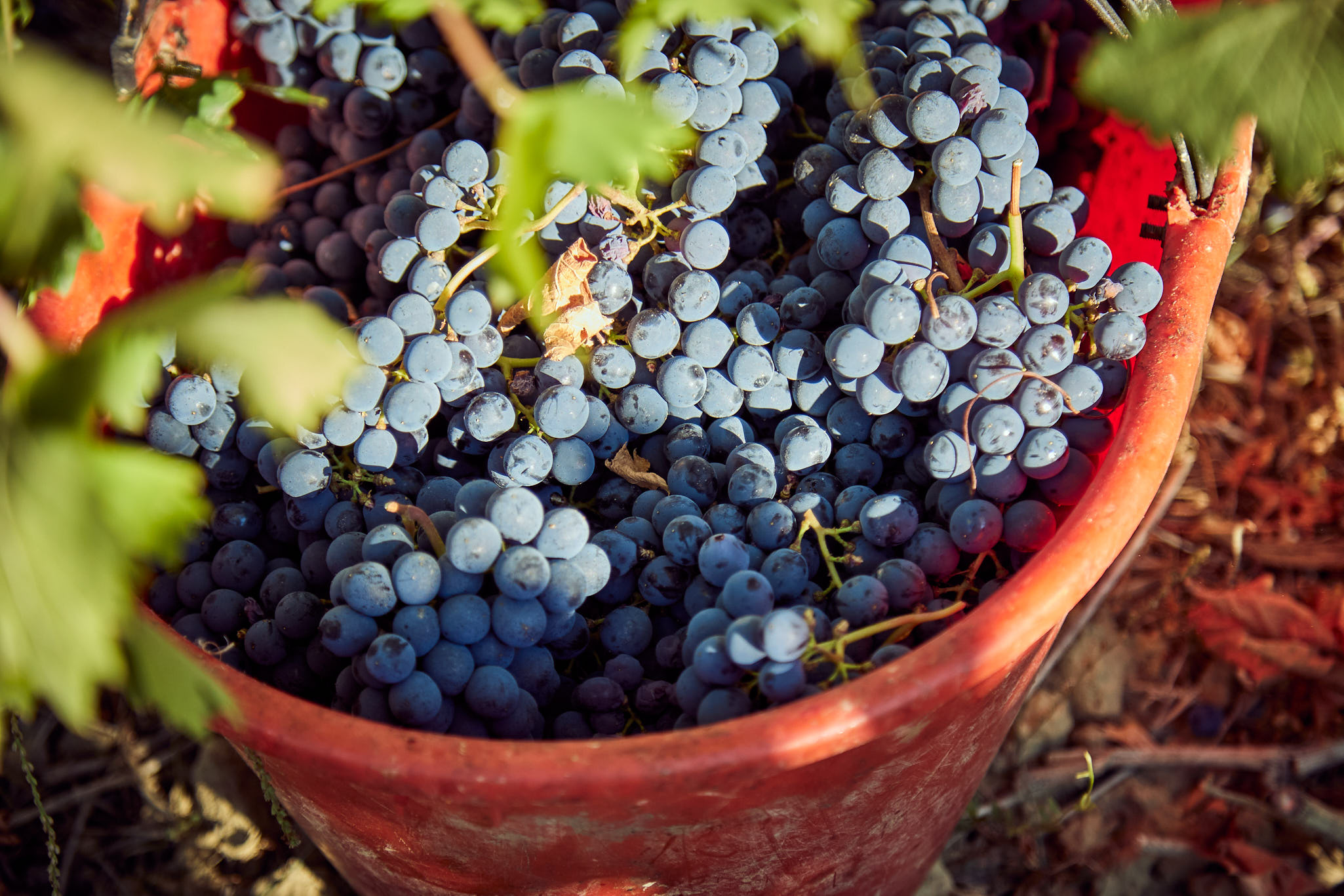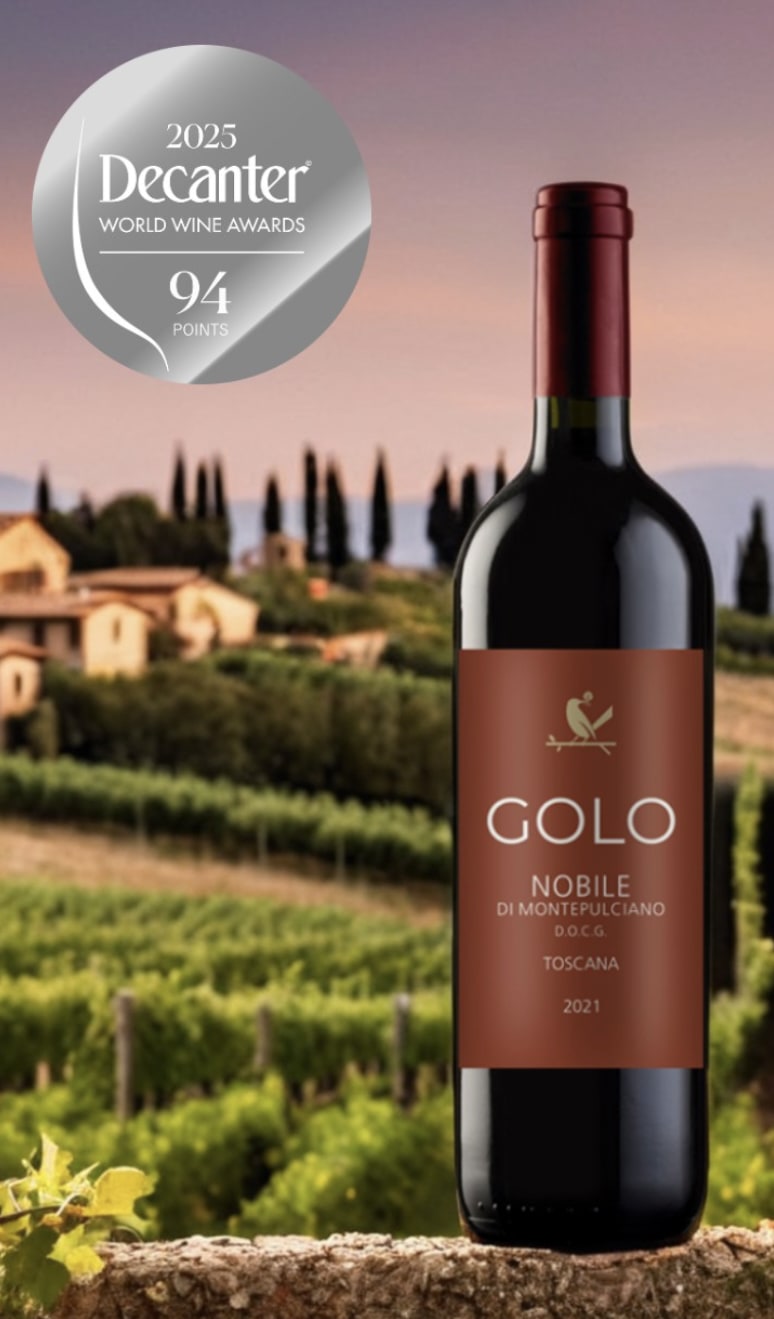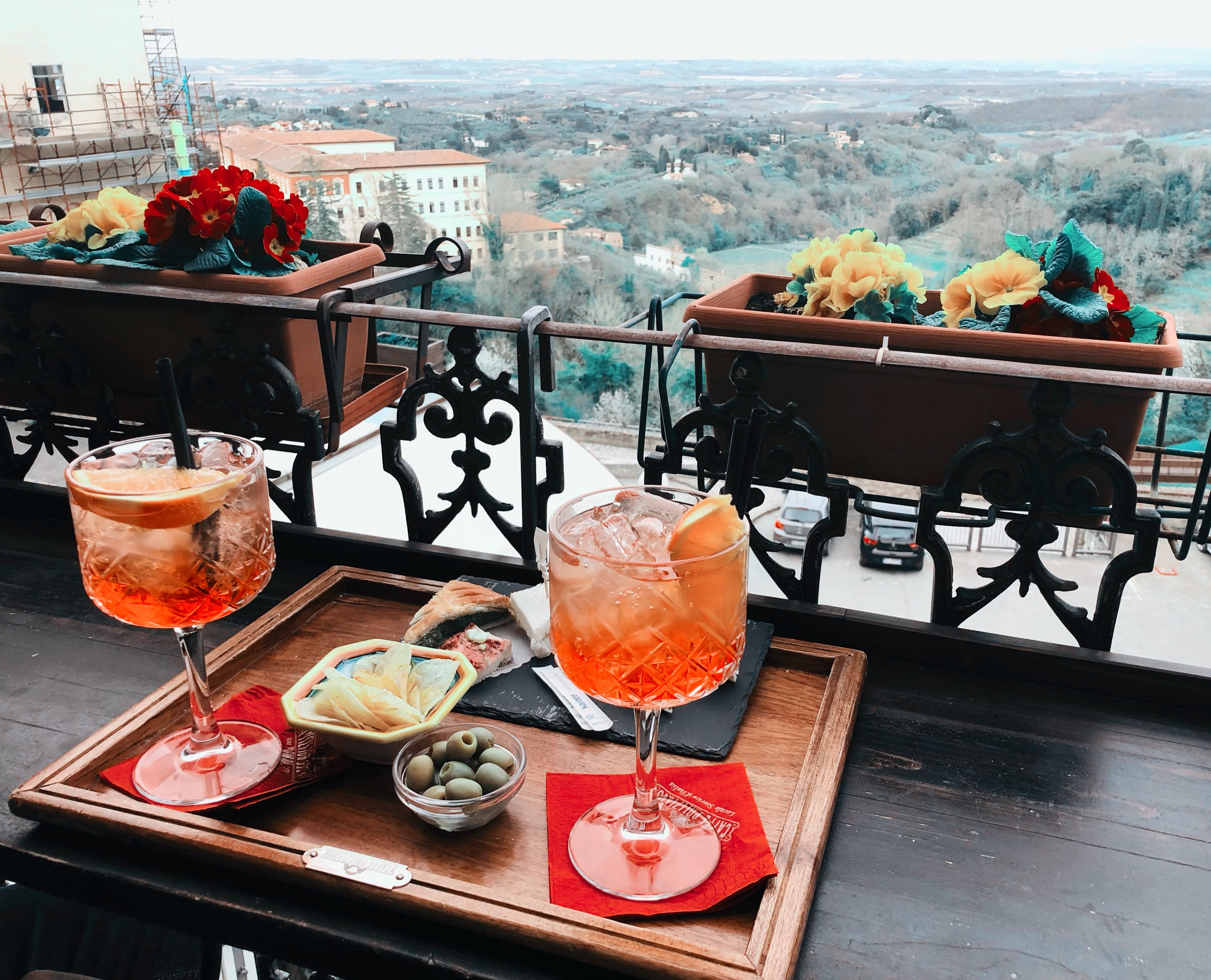Guide to Wine in Tuscany Italy: Explore the 2025 Experience
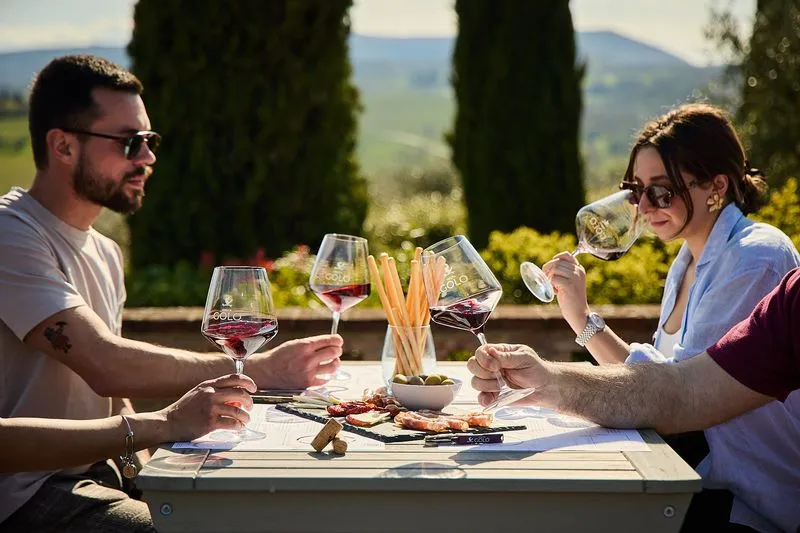
Imagine yourself savoring a glass of Chianti, surrounded by golden vineyards and ancient hill towns. This is the magic that awaits with wine in tuscany italy in 2025.
This guide is your key to unlocking the very best of wine in tuscany italy, whether you are a seasoned enthusiast or a first-time visitor. Dive into Tuscany’s rich wine heritage, discover celebrated regions, and explore immersive tasting experiences.
Get ready to uncover insider tips, the latest events, and expert travel advice, all designed to help you plan the ultimate journey through wine in tuscany italy. Your Tuscan adventure begins here.
The Legacy of Tuscan Wine: History, Terroir, and Traditions
Tuscany’s story is inseparable from its vineyards. The roots of wine in tuscany italy stretch deep into history, with evidence of Etruscan and Roman cultivation shaping the landscape for over two millennia. Ancient amphorae, medieval cellars, and Renaissance records all reveal a region where wine is tradition, livelihood, and art.
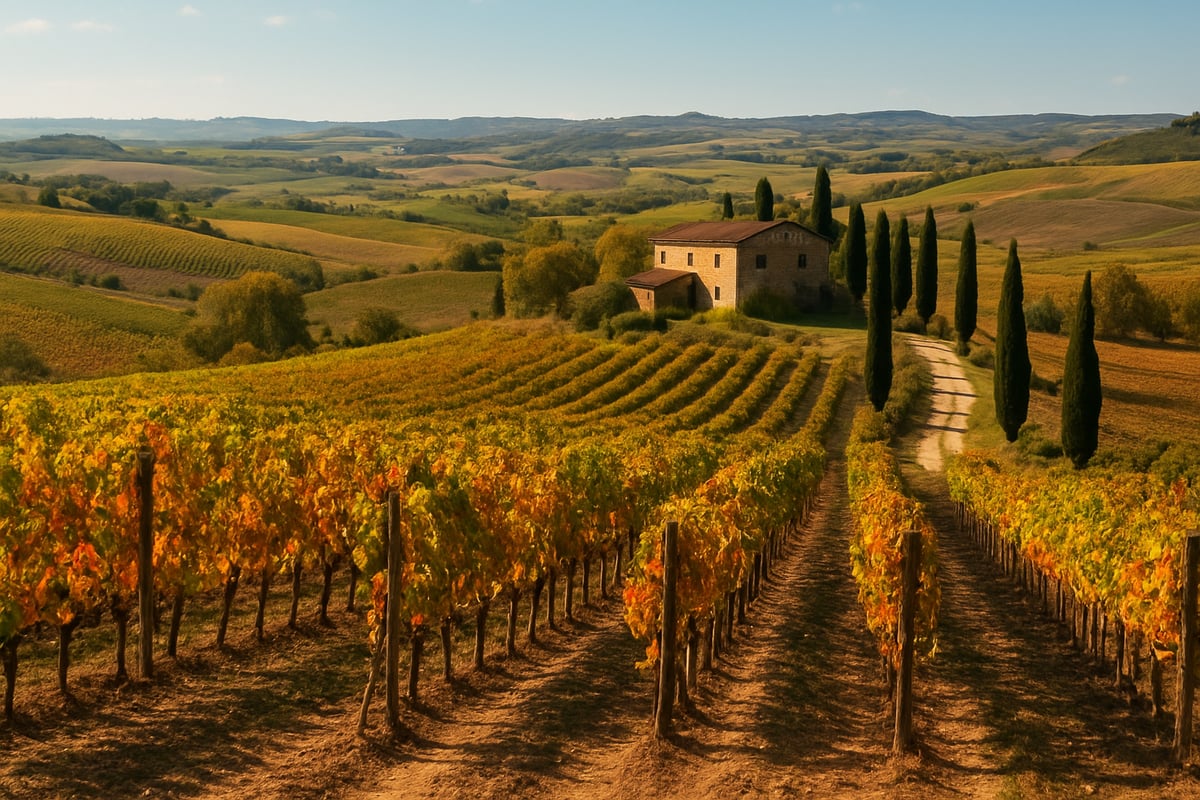
Ancient Roots and Historical Evolution
The journey of wine in tuscany italy began with the Etruscans, whose innovative farming laid the groundwork for Roman expansion. Over centuries, monasteries, noble families, and merchant guilds refined techniques, establishing the region’s reputation across Europe. By the late 20th century, the introduction of DOC and DOCG regulations formalized quality, protecting traditional practices while encouraging excellence.
To delve deeper into these enduring customs and the culture that preserves them, explore the Discover the Wine Culture of Tuscany guide.
The Unique Terroir of Tuscany
What sets wine in tuscany italy apart is its terroir. The region’s rolling hills create varied microclimates, from sun-drenched slopes to cool, misty valleys. Soils range from rocky galestro to sandy clay, each imparting distinct aromas and flavors. Proximity to the Tyrrhenian Sea moderates temperatures, while altitude influences acidity and structure.
Table: Key Terroirs in Tuscany
| Subregion | Elevation (m) | Soil Type | Wine Style |
|---|---|---|---|
| Chianti | 250-600 | Galestro | Bright, floral |
| Montalcino | 120-500 | Clay, marl | Rich, robust |
| Bolgheri | 0-100 | Sandy, loam | Full-bodied |
Traditional and Modern Winemaking
Tradition and innovation coexist in wine in tuscany italy. Ancient cellars still ferment grapes in large oak casks, honoring time-tested methods. Meanwhile, a new generation of winemakers embraces stainless steel tanks, temperature control, and organic farming. In 2025, many estates blend old and new, yielding wines of remarkable balance and character.
Iconic Grapes and Blending Artistry
The heart of wine in tuscany italy is Sangiovese, known for its lively acidity and cherry notes. Local varieties like Canaiolo and Colorino add depth, while international grapes such as Cabernet Sauvignon and Merlot appear in modern blends. This blending tradition produces a spectrum of styles, from classic Chianti to bold, contemporary reds.
List: Key Tuscan Grape Varieties
- Sangiovese
- Canaiolo
- Colorino
- Cabernet Sauvignon
- Merlot
- Syrah
The Super Tuscan Phenomenon
In the late 20th century, pioneers challenged convention by crafting “Super Tuscans” outside DOC rules. By blending Sangiovese with Bordeaux grapes and aging in French oak, estates like Antinori and Tenuta San Guido redefined wine in tuscany italy. Today, Super Tuscans enjoy global acclaim, inspiring innovation across the region.
Tuscany by the Numbers
Tuscany boasts over 65,000 hectares of vineyards and produces more than 2.7 million hectoliters annually. DOCG wines account for nearly 50 percent of total production, with exports reaching over 70 countries. The United States, Germany, and the UK are leading markets, reflecting the worldwide passion for wine in tuscany italy.
Family Estates and Small Producers
Family-owned estates are the backbone of wine in tuscany italy. Historic names like Antinori and Frescobaldi lead the way, while boutique wineries preserve local traditions and experiment with new techniques. These producers value sustainability, quality, and hospitality, offering visitors a genuine taste of Tuscan heritage.
Whether exploring a centuries-old cellar or sampling the latest vintage from a small producer, the legacy of wine in tuscany italy is alive, evolving, and ready to be discovered.
Exploring Tuscany’s Iconic Wine Regions
Tuscany is a tapestry of landscapes, traditions, and flavors, each region offering a unique expression of wine in tuscany italy. Exploring these iconic areas opens a world of tasting experiences, cultural insights, and unforgettable scenery. Let’s journey through the five most celebrated wine regions, each with its own story and signature style.
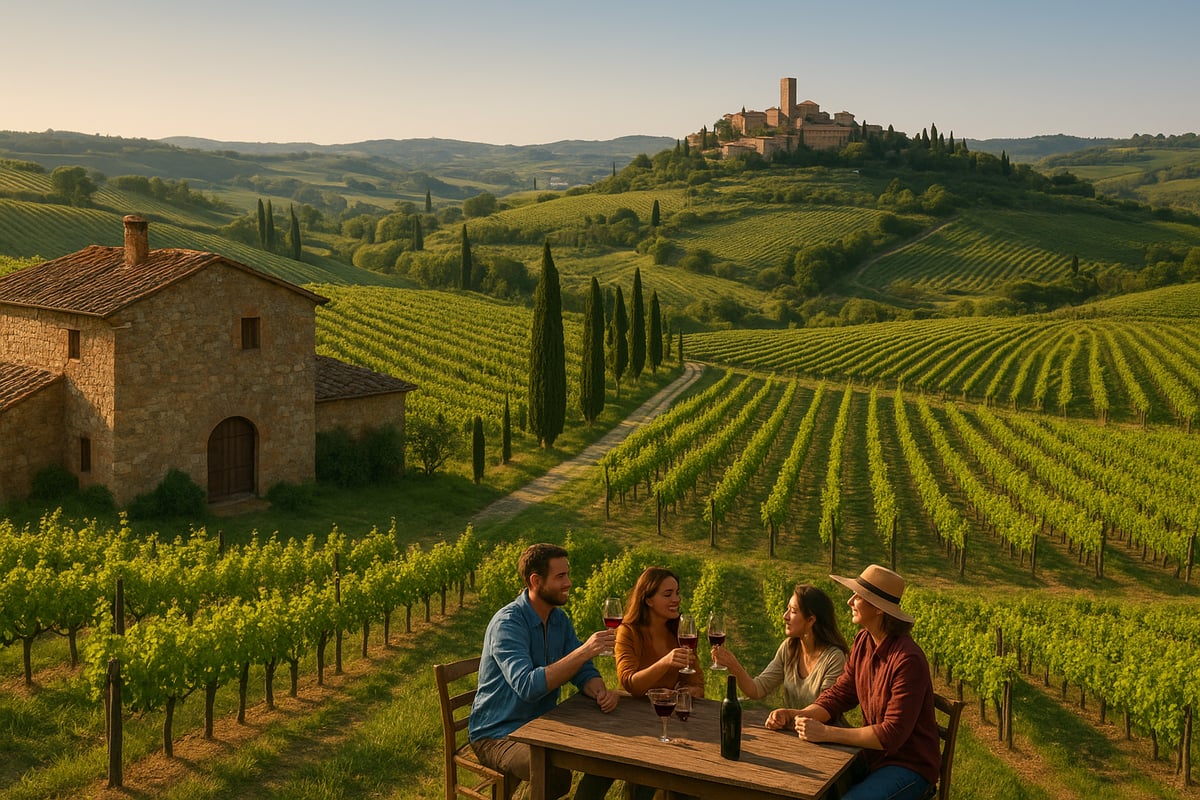
Chianti and Chianti Classico
The heart of wine in tuscany italy beats in Chianti and Chianti Classico, where gentle hills and ancient villages create a timeless atmosphere. Chianti’s boundaries stretch wide, but Chianti Classico represents the historic core, marked by the iconic black rooster seal.
Sangiovese dominates here, often blended with Canaiolo or Colorino. Top villages like Greve, Radda, and Castellina are renowned for their vibrant communities and celebrated vineyards. For culinary travelers, Chianti pairs beautifully with rustic Tuscan dishes — think wild boar ragù and pecorino cheese.
Notable wineries are preparing exceptional 2025 vintages, promising rich, age-worthy reds. Food and wine festivals thrive in the region, offering immersive tastings and cultural events. For a deeper dive into the landscape, villages, and wine styles, visit the Chianti and Chianti Classico Regions guide.
Montalcino: Home of Brunello
Montalcino, south of Siena, is a crown jewel for wine in tuscany italy. Its unique microclimate and clay-rich soils give rise to Brunello di Montalcino DOCG, one of Italy’s most prestigious wines.
Brunello must age for at least five years, resulting in complex aromas of cherry, leather, and spice. For those seeking a softer introduction, Rosso di Montalcino offers a fresher style with shorter aging.
Leading producers like Biondi-Santi and Casanova di Neri are embracing both tradition and innovation for 2025, experimenting with organic practices. Wine tourism flourishes here, with guided vineyard walks and gourmet pairings highlighting the region’s rich gastronomy. Montalcino is a must for those chasing depth and elegance in wine in tuscany italy.
Montepulciano and Vino Nobile di Montepulciano
In southern Tuscany, Montepulciano’s rolling hills are famed for Vino Nobile di Montepulciano, a classic example of wine in tuscany italy. The star grape, Prugnolo Gentile (a local Sangiovese clone), shapes wines of elegance and structure.
Vino Nobile DOCG boasts a storied history and a flavor profile of plum, violet, and earthy undertones. Rosso di Montepulciano offers a lighter, approachable alternative, while local specialties like Vin Santo add diversity.
Sustainable initiatives are increasingly common, with estates focusing on organic farming and eco-friendly cellar practices. Scenic routes wind past cypress groves and medieval towers, offering memorable tasting stops. Exploring Montepulciano means savoring tradition and innovation in every glass of wine in tuscany italy.
Bolgheri and the Coast: The Super Tuscan Revolution
Bolgheri and the Tuscan coast have redefined wine in tuscany italy with the rise of Super Tuscans. This region’s maritime climate and gravel soils nurture international grape varieties such as Cabernet Sauvignon, Merlot, and Syrah.
The creation of iconic wines like Sassicaia and Ornellaia broke traditional rules, blending French grapes with Tuscan flair. Today, Bolgheri’s estates are leaders in organic and biodynamic viticulture, setting trends for 2025.
Visitors can tour coastal vineyards, relax in luxurious wine resorts, and enjoy seafood pairings that highlight the region’s Mediterranean influence. Bolgheri is the destination for those seeking bold, innovative expressions of wine in tuscany italy.
San Gimignano and Vernaccia
San Gimignano, famed for its medieval towers, is the white wine capital of wine in tuscany italy. Vernaccia di San Gimignano DOCG stands out with its crisp acidity and notes of citrus, almond, and floral hints.
Top producers welcome guests to tastings in centuries-old cellars, where the town’s history comes alive. Local cuisine, including saffron-infused dishes and fresh pecorino, pairs beautifully with Vernaccia’s lively character.
Annual wine festivals and cultural events fill the calendar, offering opportunities to immerse in both tradition and innovation. San Gimignano is an essential stop for those seeking a unique white wine experience within the tapestry of wine in tuscany italy.
The 2025 Tuscan Wine Experience: Tastings, Tours, and Immersive Activities
Embarking on a journey to experience wine in tuscany italy is more than just tasting—it is a multisensory adventure. In 2025, wine lovers can immerse themselves in expertly curated tastings, scenic vineyard tours, authentic food pairings, lively festivals, and exclusive estate stays. Here is how to savor the best of Tuscany’s wine culture.
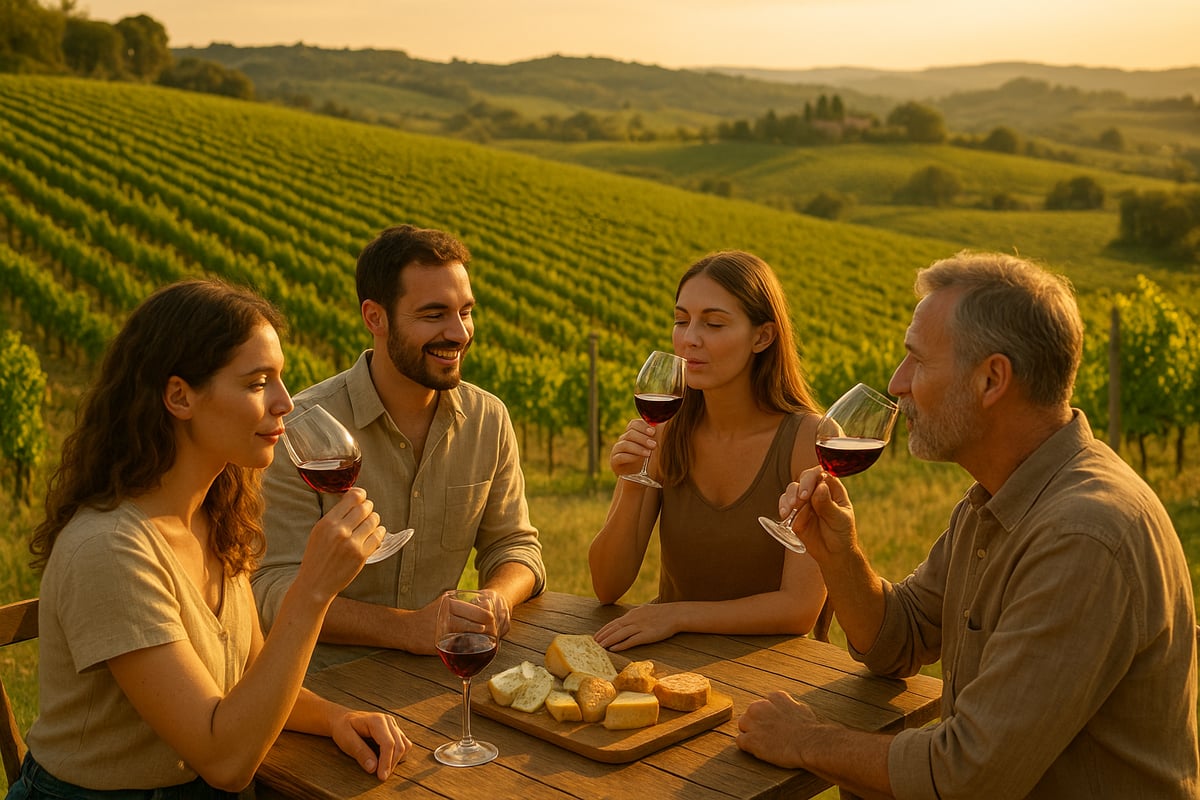
Booking the Ultimate Wine Tasting
Selecting the right winery is key to experiencing wine in tuscany italy at its finest. Options range from historic estates to boutique producers, each offering distinct tasting styles. Classic tastings introduce house specialties, while vertical tastings highlight vintages side by side. Food-paired and blind tastings add depth to your palate.
Reserve early, especially during peak harvest and festival seasons. Private tastings provide intimacy and direct access to winemakers, while group experiences foster camaraderie. Many estates offer tours in English and cater to diverse accessibility needs. For detailed information on available tastings, visit Wine Tasting and Estate Visits to plan your perfect outing.
Vineyard Tours and Cellar Visits
Guided vineyard tours are a highlight for those seeking a deeper connection with wine in tuscany italy. Walk among the vines, learn about the annual cycle from bud break to harvest, and observe traditional and modern winemaking methods. Discover the art of fermentation and barrel aging, often in ancient cellars or architecturally stunning spaces.
Meet passionate winemakers who share stories of their land and family heritage. Many vineyards showcase sustainable farming—organic and biodynamic practices are increasingly common in 2025. Photogenic cellar designs, from centuries-old caves to sleek modern builds, add another dimension to your visit.
Wine & Food Pairing Experiences
No exploration of wine in tuscany italy is complete without sampling the region’s legendary cuisine. Savor classic pairings like Chianti with bistecca alla fiorentina or Vernaccia with panzanella. Many wineries offer cooking classes where you can prepare Tuscan specialties alongside guided wine tastings.
Farm-to-table lunches and vineyard picnics are popular ways to enjoy local produce, cheeses, and olive oils. Some estates provide curated experiences that blend wine, food, and landscape in unforgettable ways. In 2025, look for creative pairings and menus that highlight both tradition and innovation.
Wine Festivals and Events in 2025
Wine festivals bring the vibrant culture of wine in tuscany italy to life. In 2025, events like the Chianti Classico Expo, Benvenuto Brunello, and Calici di Stelle will showcase the region’s best wines and producers. Newer festivals and pop-up tastings are also gaining popularity, offering fresh ways to engage.
Attend seminars, join exclusive tastings, and participate in lively auctions. Secure tickets early, as these events draw visitors from around the world. Local tips include arriving early, wearing comfortable shoes, and planning breaks to enjoy nearby villages and landscapes.
Staying at Tuscan Wine Estates
For a truly immersive experience, consider staying at a wine estate during your visit to discover wine in tuscany italy firsthand. Choose from agriturismi, boutique hotels, and elegant villas set within working vineyards. Guests often enjoy unique activities such as participating in harvest, private barrel tastings, and behind-the-scenes tours.
Accommodations book quickly during peak times, so plan ahead for 2025. Many estates offer packages with meals, tastings, and wellness amenities. Look for properties with excellent guest reviews and a focus on authentic hospitality for a memorable stay.
Understanding Tuscan Wine Labels, Classifications, and Buying Tips
Navigating the world of wine in tuscany italy begins with understanding its label language and official classifications. Whether you are a seasoned collector or a first-time visitor, Tuscan wine labels hold essential clues about origin, quality, and style. Mastering these details ensures every bottle you select in 2025 reflects the region’s remarkable heritage.
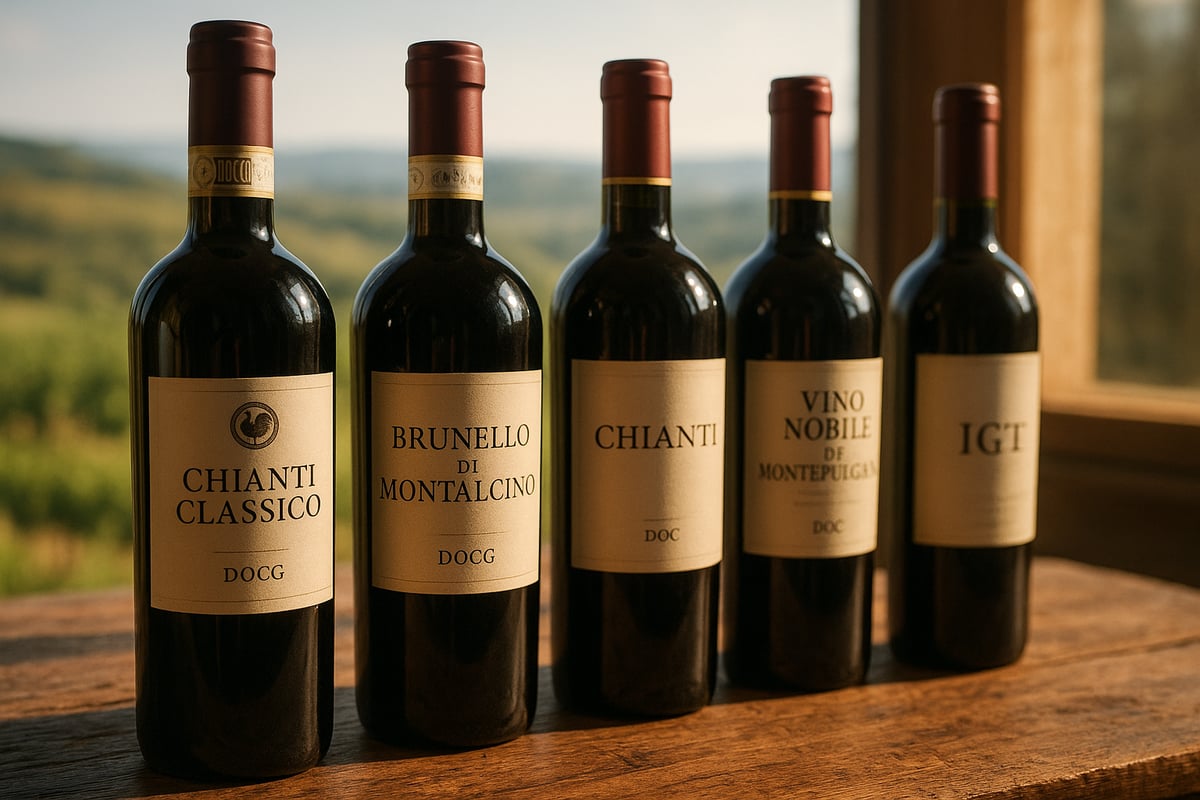
Understanding DOCG, DOC, and IGT Classifications
Tuscan wine is organized under a strict classification system, each level signifying specific standards and regional authenticity. The three main tiers are:
| Classification | Meaning | Key Features |
|---|---|---|
| DOCG | Denominazione di Origine Controllata e Garantita | Highest quality, strictest rules, taste-tested, numbered seals |
| DOC | Denominazione di Origine Controllata | Regional rules, defined grapes and styles, less strict than DOCG |
| IGT | Indicazione Geografica Tipica | Broadest, allows innovation, includes many Super Tuscans |
For a deeper dive, consult Tuscany's Wine Classification System, which clarifies the nuances and regulations behind each category. As you explore wine in tuscany italy, these classifications will guide you to bottles reflecting tradition or innovation.
How to Read a Tuscan Wine Label
Tuscan wine labels are rich in information. Here’s what to look for:
- Producer Name: The estate or bottler, often a family or historic house.
- Region/Appellation: Indicates DOCG, DOC, or IGT status, such as Chianti Classico DOCG.
- Vintage: The year grapes were harvested, signaling style and aging potential.
- Grape Variety: Sangiovese, Vernaccia, or blends, often specified for DOCG/DOC wines.
- Aging Terms: Annata (standard), Riserva (extended aging), Gran Selezione (top tier for Chianti Classico).
- Alcohol Content and Volume: Legal requirements for export and sale.
When selecting wine in tuscany italy, these details help you match your taste preferences with the region’s diverse offerings.
Deciphering Super Tuscans and Naming Conventions
Super Tuscans emerged as innovative blends that broke traditional rules, often labeled under IGT. Instead of following DOCG blending restrictions, these wines combine international grapes like Cabernet Sauvignon and Merlot with local varieties. Names like “Sassicaia” or “Tignanello” often signal Super Tuscan status, though the term itself does not appear on labels.
For wine in tuscany italy, understanding these naming conventions unlocks a world of creative, world-class wines. Super Tuscans may feature proprietary names, creative blends, and modern design, making label reading both exciting and essential for discerning buyers.
Aging Terms and Buying Tips
Tuscan wines use specific aging terms to indicate style and quality. Here’s a quick reference:
- Annata: Basic vintage, minimum aging.
- Riserva: Longer aging, more complexity.
- Gran Selezione: Exclusive to Chianti Classico, top-tier selection, strictest requirements.
When buying wine in tuscany italy, consider tasting at estate wineries, where you can often sample Riserva and Gran Selezione directly from the source. Shops and online platforms offer broader selections, but always check for proper storage and authenticity, especially for older vintages.
Export Data, Shipping Advice, and Label Examples
Tuscan wines are beloved worldwide, with Chianti Classico, Brunello di Montalcino, and Vino Nobile di Montepulciano leading exports to the US, UK, and beyond. If you wish to ship wine in tuscany italy home, ask producers about legal limits and recommended shipping services. Many wineries provide export-friendly packaging and documentation.
For specific examples, explore Vino Nobile di Montepulciano Wines to see how labels reflect DOCG status, vintage, and estate details. Comparing labels side by side reveals variations in tradition, innovation, and quality—each bottle is a story waiting to be discovered.
Planning Your Tuscan Wine Journey: Travel Tips, Itineraries, and Local Insights
Embarking on a journey to experience wine in tuscany italy is an adventure that rewards thoughtful preparation. From the rolling vineyard landscapes to medieval towns, every detail counts when planning your visit. This section provides you with essential travel tips, sample itineraries, and local insights to ensure your exploration of wine in tuscany italy is seamless, memorable, and truly authentic.
Best Times to Visit and Seasonal Considerations
Timing is crucial when planning your trip for wine in tuscany italy. The region experiences a Mediterranean climate, with warm summers and mild winters. Spring (April to June) and early autumn (September to October) are ideal for wine in tuscany italy, as vineyards are lush and the weather is pleasant. These months coincide with key vineyard cycles, from flowering to harvest.
Peak wine tourism occurs during the autumn harvest, when the landscape comes alive with activity and festivals. If you prefer fewer crowds, consider visiting in late spring or after the main harvest in late October. Off-season visits often offer more personalized attention at wineries.
Remember to pack layers, comfortable walking shoes, and a light rain jacket, as weather can be unpredictable. Booking accommodations and tastings early is recommended, especially during major events and the grape harvest.
Building the Ultimate Wine Itinerary
Designing an itinerary for wine in tuscany italy means balancing world-famous estates with hidden gems. Popular routes include the classic Chianti loop, which connects iconic villages like Greve, Radda, and Castellina, and the southern journey through Montalcino and Montepulciano. For those seeking coastal influences, the Bolgheri wine road offers a taste of the Super Tuscan revolution.
Sample itineraries can range from a quick three-day tour focused on a single region, to a week-long exploration covering multiple DOCG zones. Mix visits to historic estates with boutique wineries, and allow time for local markets or spontaneous detours. For inspiration on unique winery stories, the Golo Rosso di Montepulciano Story highlights how new stars are born in traditional regions.
Transportation options include renting a car for flexibility, hiring a private driver, or joining guided wine tours. Always plan ahead, as some rural wineries are only accessible by car.
Insider Tips for an Authentic Experience
To truly connect with wine in tuscany italy, embrace local culture and traditions. Engage with family-run wineries and take time to converse with winemakers—many are passionate about sharing their stories. Learning a few Italian phrases can bridge language gaps and deepen your appreciation for the region.
Respect local etiquette by arriving punctually for tastings and dressing smart-casual. Supporting sustainable producers and small estates helps preserve Tuscany’s winemaking heritage. Don’t hesitate to ask locals for recommendations, as they often lead you to off-the-beaten-path experiences.
Keep your schedule flexible, allowing for spontaneous vineyard picnics or unexpected village festivals. These moments often become the highlights of your wine in tuscany italy journey.
Wine & Wellness: Beyond the Glass
For travelers seeking rejuvenation, wine in tuscany italy offers more than tastings. Many estates feature on-site wellness retreats, where you can unwind with vineyard-view spa treatments or yoga classes among the vines. Some properties offer vinotherapy, using grape extracts in facials and massages.
Outdoor enthusiasts can combine wine exploration with cycling, hiking, or even horseback riding through scenic vineyards. Farm-to-table lunches, olive oil tastings, and cooking classes further enrich your experience.
Leading wine resorts and boutique hotels often curate wellness packages, blending relaxation with immersive wine culture. This holistic approach ensures your journey through wine in tuscany italy is both indulgent and restorative.
Budgeting and Making Reservations for 2025
Understanding costs is key to a successful trip focused on wine in tuscany italy. Tasting fees typically range from €10 to €40 per person, with premium or private experiences costing more. Accommodations vary widely, from affordable agriturismi to luxury vineyard resorts.
Book winery visits and lodging well in advance, especially during high season and around major wine festivals. Consider purchasing tasting passes or bundled tours for better value. Use reputable reservation platforms and check cancellation policies before confirming.
Cash is still preferred in some rural areas, while credit cards are widely accepted in cities. Tipping is appreciated but not obligatory. For up-to-date pricing and trusted booking resources, consult local tourism boards and estate websites before your 2025 adventure.
As you dream about your journey through Tuscany’s rolling hills and storied cellars, imagine the unique memories waiting for you at an estate like Tenuta Golo. Here, you can immerse yourself in the flavors of Nobile di Montepulciano, stroll through vineyards steeped in history, and experience genuine Tuscan hospitality in a breathtaking setting. If you’re ready to make your 2025 wine adventure truly unforgettable, why not take the next step and Book Your Wine Tasting Now? Your glass of Tuscany awaits.


